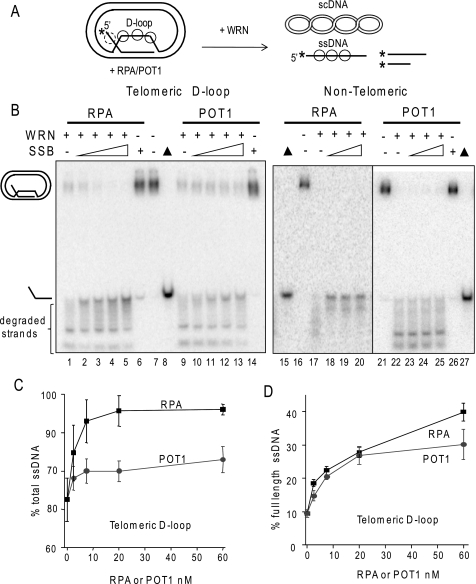FIGURE 3.
RPA and POT1 promote WRN release of full-length strands from mobile telomeric D-loops. A, a schematic is shown for the branch migration of mobile plasmid D-loops with 3′ invaded ssDNA and a 5′ ssDNA tail. The asterisk denotes a radiolabel, and scDNA indicates the supercoiled dsDNA product. Circles with solid lines indicate RPA or POT1 binding, and circles with dashed lines indicate only RPA binding for the telomeric D-loop (not to scale). B, the telomeric (lanes 1–14) or non-telomeric (lanes 15–27) mobile D-loops (50 pm) were incubated with 5 nm WRN and increasing concentrations (0, 2.5, 7.5, 20, or 60 nm) of either RPA or POT1 as indicated for 15 min under standard reaction conditions. Control reactions contained substrate with either 60 nm RPA (lane 6) or POT1 (lane 14). Reactions were run on a 4–20% native polyacrylamide gel and visualized by PhosphorImager analysis. ▲, heat denatured substrate. C, for the telomeric D-loop, the percentage of total displaced ssDNA was calculated as described under “Experimental Procedures” and plotted against RPA or POT1 concentration. Squares and black line, WRN and RPA; Circles and gray line, WRN and POT1. D, for the telomeric D-loop, the percentage of full-length ssDNA product was calculated as described under “Experimental Procedures” and plotted against RPA or POT1 concentrations. Filled squares and black line, WRN and RPA; filled circles and gray line, WRN and POT1. Values represent the mean and S.D. from at least three independent experiments.

